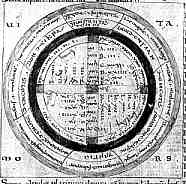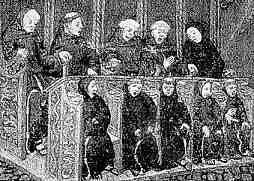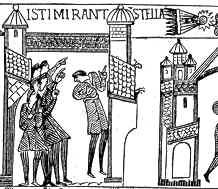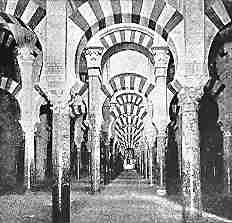 |
|
Works on Astronomy and Astrology |
|
In the area of study of the heavenly bodies, we run straight into the issue of the classification of knowledge. In the middle ages science, religion, practical or technical knowledge, folklore, magic and superstition were not packaged commodities, as in our knowledge system today. Religion informed all literate knowledge, which is hardly surprising given that the church was the engine room of literacy, but contrary to some popular belief, it did not ban all scientific enquiry. It did, however, assert authority over the nature of that enquiry, and over the practices that could be carried out using the knowledge from that enquiry. There was an especially uneasy relationship between religion and magic, demonstrated by the relationship between astronomy and astrology. |
|
| |
A
medieval depiction of the sun and stars, from a 15th century stained glass
window in the church of All Saints, North Street, York. |
| As we sit today in artificially lit offices in front of flickering screens, switching the lights on at dusk and wandering around at night in illuminated and polluted cities where the night sky is greyed out, it is difficult to understand how much knowledge of the sky was once a part of everyday life in every society on earth. It was the fundamental core of the measurement of time, in relation to the daily cycle of work as well as the annual round of agricultural activities. It is also a mysterious and mystical thing, with certain heavenly bodies following easily predicted patterns, while others involve more complex computation. The more predictable patterns have obvious implications for ordinary life: the sun controls the daily round of work, the moon controls the tides and certain agricultural activities, and the patterns of stars in the sky, especially those constellations that we call the zodiac, regulate the annual round of production. Rare conjunctions of more difficult to predict astral events were thought to possibly signify unexpected events on earth, especially disasters. |
 |
The computation of time was also a significant matter for the church. For a start, every liturgical book contained a calendar indicating the significant feasts over the course of the year. A common motif for the decorations of calendar pages, from early psalters to late medieval books of hours, was the representation of the zodiac sign for each month, often accompanied by an image of an appropriate labour of the month. In this way, the concerns of working life were connected to the work of the church. Astronomical observation is peeping into a religious text. The example at left shows that these motifs were sufficiently important to be included in sculptural programs in sacred spaces. |
| Zodiac signs of Cancer and Aries above their appropriate labours in the north portal of the west door of Chartres Cathedral. |
| A technical problem for the church, especially in the early middle ages, before they worked it out properly, was the calculation of the date of Easter, which involved co-ordinationg the lunar calendar, on which Easter is based, with the solar calendar, which controlled everything else. Complex expositions known as computistical texts combined astronomical observations with mathematical calculations and fiendish diagrams to batter this knotty problem into submission. |
|
| A computistical diagram f rom the late 11th century (British Library, Cotton Caligula A XV, f.125v). By permission of the British Library. |
| This essentially makes astronomy into a mathematical discipline, which is where it tended to sit in the medieval period. It is only at the very end of the middle ages that the first beginnings of observational technology presaged the development of astronomy as a branch of the natural sciences |
| While the labourer in the fields set his daily round of work by the sun, adjusting it according to the season, the church had the necessity for the measurement of time for its daily round of divine office. The pattern of the various offices varied between winter and summer, reflecting the pattern of days, but methods were needed to calculate the time for Matins, held during the hours of darkness. |
|
Monks in choir, from a terrible reproduction of a beautiful manusript picture. |
| Gregory of Tours, in the later 6th century, evidently gave quite complex instructions for calculating the times of the night offices by observation of the stars, as well as using chanting the Psalms as a measurement of time intervals. Good trick, that one, chanting the Psalms so as to be able to get up in time to chant the Psalms. The hours themselves at that time were a variable commodity, changing in length over the year as the relativity between the lengths of daylight and darkness varied. Simple devices, such as sundials or quadrants, could be used to make an approximation of the time in daylight hours; good enough for the days before train timetables. |
 |
Sample from annals of 791 from the abbey of Lorsch (Vatican Library, Palat. 966, f.53v). |
| Annals and chronicles, such as the example shown above, frequently included references to notable astronomical events that had occurred. These were generally the less predictable events, which can often be identifed as as comets, meteorite showers, eclipses or spectacular occurrences of the aurora borealis, as well as unexplained lights in the sky. Along with rains of blood, frogs or fish, plagues of locusts, earthquakes and unnatural seasonal events such as roses in winter or two crops of apples, these were regarded as portents of significant events, usually bad ones. Given the regular occurence of famine, pestilence, drought and flood and the violent or sudden deaths of monarchs or members of their families, there was often some disaster or other that could be hung on them. However, this involved the elementary observation of celestial events, with no ability to predict them. |
| The appearance in the sky of a bright celestial object just before William the Conqueror set off conquering was considered sufficiently significant that it was recorded on the Bayeux Tapestry. We know that this was an appearance of Halley's Comet, named after a much later astronomer who thought he had discovered it. |
|
| A portentous comet causes wonderment in the Bayeux Tapestry. |
| The knowledge of astronomy that existed in ancient times, such as the works of Ptolomy in the 2nd century AD, did not travel by a direct route with the missionising monks who carried the Christian religion to pagan Europe. They had other more immediate concerns. The transmission of astronomical, and other scientific and mathematical works, was conditioned by the churning of peoples and cultures that occurred around the Mediterranean. |
| The Arab populations which expanded around the southern and eastern Mediterranean absorbed works such as those of Ptolemy, as well as material from Persian cultures. These Arab texts were transferred to Spain with the Muslim conquest and filtered into the western tradition from there. These works allowed more accurate predictions to be made of such things as the movements of the planets and eclipses. |
|
The interior of the mosque at Cordova, in Spain. |
| So how did they manage to understand these things when they supposedly believed the earth was flat and also the centre of the universe? Well, it seems they didn't really think it was flat. Like a lot of other things, they just drew it that way. They also drew Jerusalem in the very middle of it, and it is quite possible to have two conflicting truths operating at the same time, providing they each stay in their own conceptual spheres. It's only when somebody insists on a single absolute truth that things get ugly. Meanwhile, the rediscovered astronomy found a place in the knowledge system. |
|
continued
 |
 Categories
of Works Categories
of Works |
|
 |
 |
 |
 |
 |
 |
 |






